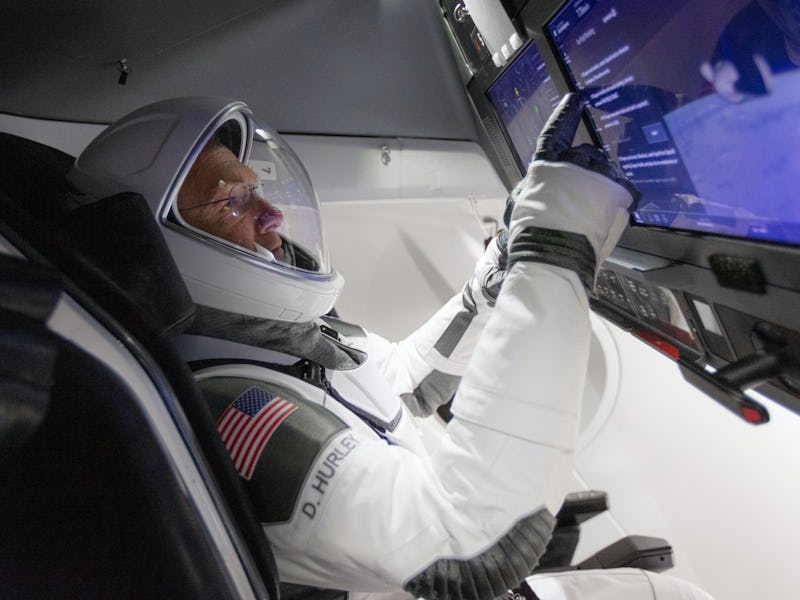SpaceX Crew Dragon: stunning photo shows how it improves on space shuttle
The human-carrying capsule, which debuted last month, is a hi-tech vision of the future of space travel.

The Crew Dragon, SpaceX's human-carrying capsule, has redefined spaceflight in more ways than one.
Over the weekend, an image shared on the "SpaceXLounge" subreddit showed how the new capsule compares to NASA's old space shuttle. The image compares the shuttle as it appeared for its final mission in 2011, alongside the Crew Dragon's interior for its 2020 mission.
Nine years later, it seems the spacecraft of the future is a whole lot sleeker. Gone are the dials and switches of yesteryear. In its place is a series of LCD touchscreen displays, operatable using the SpaceX suit's gloves. Where the space shuttle looked like a complicated pilot's cabin, the Crew Dragon looks a whole lot more like a movie set's interpretation of what a spaceship should look like.
Perhaps little wonder, then, that SpaceX CEO Elon Musk has a fondness for space-based science fiction novels.
The comparison demonstrates one of the biggest visual differences in how NASA will send humans into space. The iconic space shuttle took its first flight in 1981, and until 2011 was used to transport astronauts to and from the International Space Station. When the program ended, NASA started renting seats on Soyuz rockets from Baikonur Cosmodrome in Kazakhstan.
The NASA Commercial Crew program is aimed at starting a new era for its space operations. Working alongside SpaceX and Boeing, the program is aimed at creating a new means of sending NASA astronauts to the space station. The Crew Dragon is the first capsule from the program to send a human into space, an achievement it set when it sent up astronauts Doug Hurley and Bob Behnken on May 30, 2020.
Hurley was also on the last space shuttle mission, dubbed STS-135. That mission took off on July 8, 2011. In the below image, Hurley is pictured alongside fellow astronaut Chris Ferguson on the second day of the flight.
Ferguson (left) and Hurley.
Ferguson is set to fly on the maiden voyage of Boeing's capsule, the CST-100 Starliner. Ferguson will be joined by Eric Boe and Nicole Aunapu Mann.
Hurley and Behnken took off to the space station using the new Crew Dragon last month. The screens give an overview of important information, while also enabling the team to take over the otherwise-autonomous docking process if necessary.
Doug Hurley using the new Crew Dragon's systems.
SpaceX engineers explained in a Reddit discussion over the weekend that the computers powering the screens use Chromium and JavaScript. These are technologies normally associated with the world wide web, but here they're used to serve up the impressive interface. Ahead of the flight, SpaceX launched an in-browser game version of the docking process to enable fans to give it a try at home.
While the two vehicles look radically different, their operation may not be as different as it seems. During an interview with Inverse last month, Hurley explained the difference between the two:
"In this case it's quite a bit different because, from an entry perspective, a capsule, as well as shuttle, you adjust the heat shield such that it absorbs the plasma as you're re-entering, and that is done automatically by Crew Dragon. Shuttle was also automatic for the most part, but we could fly it manually in the phase of flight as well. And then we have some ability, depending on if there are certain failures, to be able to deploy the chutes manually, both the drogues and the main. But with a capsule landing in the water, obviously the precision of where you're landing is not quite as great as it was with the shuttle where you absolutely needed to land on a runway, and a big runway at that."
The Inverse analysis – SpaceX's Crew Dragon capsule looks impressive, but the space shuttle will be missed. Fans noted in response to the comparison that the older shuttle had a "true space ship feel," perhaps due to its association with NASA's previous decades of flight.
Certain visual elements will remind space-watchers of the agency's most iconic breakthroughs. NASA suggested it recognized this when it revived the beloved 1970s-era "worm" logo for the Falcon 9 booster that launched the Crew Dragon. While the future-facing Crew Dragon is exciting, the shuttle will likely remain an iconic symbol of NASA's technology.